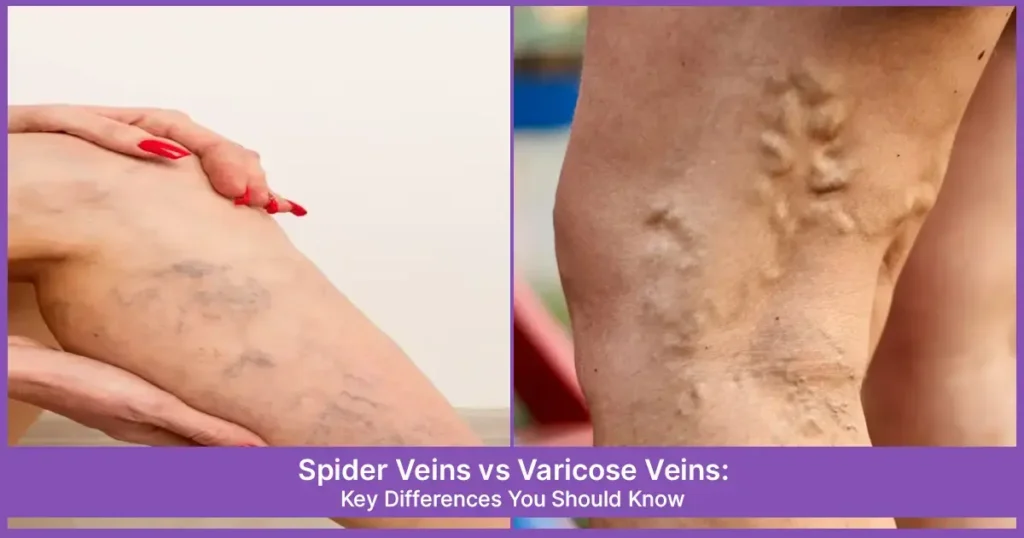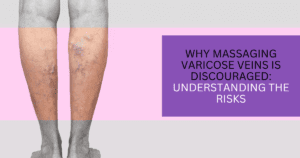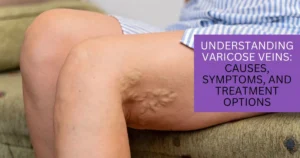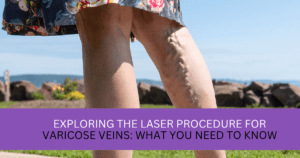When it comes to vascular health, spider veins and varicose veins are both classified as vascular abnormalities. Do you want to explore the pivotal differences between them? From different symptoms and causes to treatment options, this article unravels the distinctions surrounding these common conditions. Here is the comprehensive comparison between spider and varicose veins that everyone should know for an informed decision.
Overview of Spider Veins
Spider veins target small blood vessels, and they develop when small venous structures like capillaries, venules, and arterioles are affected in some way. These veins can be red, blue, purple, or green in shade. They typically show up in clusters that appear like a spider web.
Varicose Veins Overview
They are bigger and are easily visible. They usually appear like lumps, bumps, or ropey nodules beneath your skin surface. The size and location of varicose veins determine their blue-green appearance. Varicose veins normally occur on your legs, maybe your feet, and even on your ankles.
Symptoms and Causes of Spider Veins
Spider veins appear as a series of fine, squiggly lines or a web-like pattern. Normally, these veins are innocuous and don’t cause pain. Though they can sometimes lead to serious discomfort, heaviness, or itching around the trouble spot. Mostly, such veins are merely a point of cosmetic concern.
Multiple factors cause the development of spider veins, such as:
- Genetic: If this vascular problem runs in your family history, the likelihood is higher.
- Age: Aging promotes the chances of developing spider veins.
- Hormonal Fluctuation: Pregnancy, birth control pills, or menopause can be the possible cause of spider veins.
- Continuous Same Posture: Being on feet or sitting for many hours can lead to the formation of spider veins.
- Obesity: Carrying extra weight can make it harder for blood to flow properly through your veins.
Symptoms and Causes of Varicose Veins
Let’s explore some of the symptoms of varicose veins that can go from mild to severe and may include:
- Bulging, twisted veins.
- Swelling in the ankles, feet, or legs.
- Discomfort and itching sensations.
- Skin modifications, including discoloration or thickening of the skin around the impacted zone.
- A heavy feeling in the legs or pain, especially after staying in the same posture for long periods.
Unlike spider veins, varicose veins can end up in complications, including skin ulcers, blood clots, or bleeding. Mostly, vein doctors suggest treatment in such conditions.
Weakened or damaged valves inside the veins give birth to varicose veins. When these valves refuse to perform, blood begins to flow backward, pooling in the veins and causing them to bulge. The causal factors typically are:
- Aging
- Family medical history
- Pregnancy
- Standing or sitting for long hours
- Extra body weight
Explore Distinctions Between Spider and Varicose Veins
Although spider veins and varicose veins share similar causes and risk factors, they differ in several important ways. Let’s examine key differences between the two conditions:
The appearance and size
Let’s start with the outlook and size of both types of vascular issues. A varicose vein is more bulging. Spider veins are comparatively smaller, red or blue in color. They are typically closer to the upper side of the skin. Varicose veins are often 3 mm in diameter, while spider veins are smaller in diameter.
The complications
Varicose veins can lead to health problems such as bleeding, skin ulcers, and rupture, whereas spider veins are harmless and more cosmetic in concern.
The symptoms
Varicose veins cause serious aching, frustration, and a feeling of swelling in the legs. On the flipside, spider veins typically do not show such symptoms. However, some mild discomfort, itching, or pain, particularly in their legs, can occur.
The risk factors
Certain factors significantly boost the risk level. These include excessive weight, childbirth, etc. Some theories have suggested that spider veins often arise from varicose veins.
The insurance coverage
Insurance companies normally cover vascular treatments due to the above-mentioned complications that varicose veins can cause. Whereas spider vein treatment is more cosmetic in concern and is hardly covered by insurance.
The treatments
Varicose veins demand somewhat deeper procedures than spider veins. Some effective clinical options for varicose veins are:
- Endovenous Laser Ablation
- VenaSeal
- Sclerotherapy
- Radiofrequency Ablation Therapy
All the fundamental differences to classify both vascular conditions are discussed above. If you are experiencing any of these two: varicose or spider veins, don’t hesitate to consult a vascular specialist at a professional vein clinic near you so they can properly diagnose your condition and recommend a personalized treatment plan.




